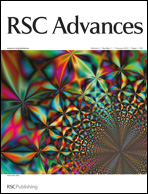The morphology and microstructure of poly(L-lactic acid) (PLLA) with different amounts of self-assembled 1,3:2,4-dibenzylidene-D-sorbitol (DBS) nanofibrils were examined using polarizing optical microscopy (POM), scanning electron microscopy (SEM), and small-angle X-ray scattering (SAXS). A small amount of DBS (less than 4 wt% DBS) changed the spherulitic morphologies and microstructures of PLLA. The formation of concentric-circled PLLA spherulites was due to the aggregation of DBS nanofibrils around the inside circles (or inside the spherulites). The concentric-circled spherulites were easily obtained at high DBS contents and high PLLA crystallization temperatures. However, at higher crystallization temperatures, the average diameter of the inside circles would exceed the final spherulite size of PLLA. Meanwhile, the DBS nanofibrils were mostly outside the spherulites. Therefore, the concentric-circled structures were not observed. Both the DBS content and PLLA crystallization temperature influenced the formation of concentric-circled spherulites. Moreover, PLLA crystallization temperatures seemed to have slightly larger effects. The crystallization temperature affected the nucleation and spherulite growth rate of PLLA, and thus altered the aggregation of DBS molecules and nanofibrils thereof. SAXS results indicated the long period of the PLLA samples was not significantly influenced by the formation of the concentric-circled spherulites. However, the maximum peak of PLLA broadened when DBS was added. The DBS nanofibrils influenced the regularity of PLLA lamellae, leading to the broader peak.

You have access to this article
 Please wait while we load your content...
Something went wrong. Try again?
Please wait while we load your content...
Something went wrong. Try again?


 Please wait while we load your content...
Please wait while we load your content...